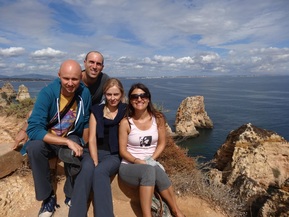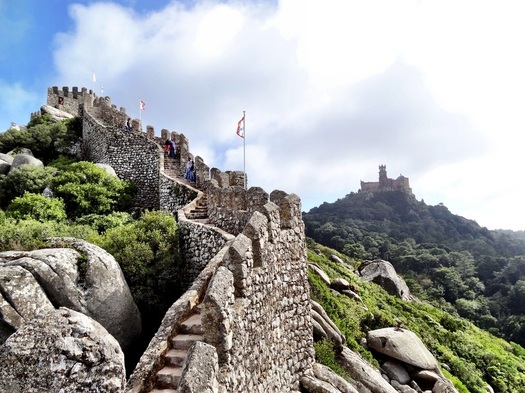How is it that one tiny area of land can embody man’s greatest achievements and his most despicable depravity? The most Southwesterly part of Europe manages to do just this. We arrived in Lagos,
Portugal and were dazzled by its gorgeous coastline replete with fresh seafood restaurants servings up the famous
sardines native to the area. It is from Sagres, just a few kilometers away, that
Prince Henry the Navigator set up his famous school that would usher in the age of Discovery. Sagres sits on the cliffs overlooking the Atlantic and was long considered the edge of the world by sailors. It was thought that to sail far beyond its shores would lead only to monsters, darkness, and to boats falling off the very face of the earth.

The Cliffs of Sagres
Henry’s school accumulated the knowledge that would allow for this “edge” to be challenged. Through the development of an improved astrolabe, improved maps, and the new ship design of the caravel, he was able to send its students to places hitherto uknown in the world. Columbus studied there before getting sponsorship by Spain for his voyage to the New World. In 1488 Bartolmeu Dias was the first man to round the Cape of Good Hope and in 1498, Vasco Da Gama opened up the sea route to India, both after studying at Henry’s school.

And yet the area has a nefarious past as well. For it was here in 1444, that Europe’s first Slave market (the Mercado de Escravos) was opened. From Lagos, thousands of Africans were dispersed through Europe, unjustly forced to perform labor after being snatched from their homes. The famously religious Prince Henry (who was part of the Order of Christ, deriving from the Knights Templar) received one-fifth of the selling price for each slave as he was the major sponsor of the expeditions to Africa. The image to the left depicts the front of the slave market, where ropes have been strung together to represent that first shipment of 275 slaves brought into Europe in 1443.

With these themes juxtaposed in our minds, we met up with some wonderful couchsurfers in Lagos who made our stay there truly memorable. Lijana and Andrius are Lithuanians who are traveling the world, living in different locations, and supporting themselves remotely with their website that sells
Halloween Costumes (check out their site if you need a costume!). They were an inspiring couple to meet with as they took their wanderlust and made it into a viable profession while also generously sharing their home with surfers like us. But beyond serving us delicious vegetarian meals, they also picked us up from our hike along to the coast to the gorgeous Ponta da Piedade (the Point of Piety) and drove us up to Sagres, where we saw the cliffs that seaman for years considered the edge of the world.

The views along the coast of the Point of Piety
But after a quick photo where all the tourists were, we got to go a lot deeper. Adrius & Lijana are avid rock climbers and discovered some great routes just down on the famous cliffs. They took us to their favorite spot, an isolated cove where you can climb the sheer rock walls while the crashing waves and setting sun provides an utterly picturesque background (as you can see from our numerous
photos and videos on our Flickr page). As we climbed at the edge of the world with our new friends, we felt a tinge of inspiration and trepidation that those long-gone sailors must have felt looking out into the unknown before setting off on their journeys.

Our "secret" rock climbing cove - not far from where the tourists roam above...

Fado Singer
With so many sailors never returning from their journeys to the unknown, a musical art form known as Fado would eventually develop. Translated as “fate” Fado is a mournful, soulful style of singing where the singer bemoans the tragedies of the sea, unrequited love, and our inability shake loose from what fate offers us. Upon arriving in
Lisbon, the capital of Portugal, we attended a
Fado concert our first night to see what is all about. We enjoyed the music and the singers’ voices, though the current tradition of Fado is far from the spontaneous plebian singing that dominated the docks and taverns of old Lisbon. Rather, Fado is now sung in classy restaurants where a minimum amount of money must be spent to even sit down.

The Cloister in Jerónimos monastery - and I get to enjoy it far more than any monk did!
The rest of our time in Lisbon was spent exploring the old neighborhood of Alfama, the gorgeous Manueline sea-inspired architecture of Jerónimos Monastery,
Belem Tower, and the
Monument to the Discoveries. The intricate detail work in the carvings of the cloister at Jerónimos Monastery were particularly impressive. We also filled ourselves up with fried cod-balls and sandwiches in the local food bars, an interesting cultural experience in which locals will eat a bite and a beer quickly at the bar rather than pay more to sit down at the tables outside. But in the end we grew tired of Portuguese food and were delighted to partake in some excellent all-you-can sushi restaurants that parlayed Lisbon’s wonderful seafood into delicious Japanese morsels at a fraction of the price of other areas we have traveled!

The Walls of the Moorish Castle with Pena Palace in the background
On a daytrip from Lisbon we went out to the fairytale land of Sintra, which is overlooked by the remains of an ancient Moorish Castle dating from the 8th Century. But it is most famous for its two palaces: the Sintra National Palace and the Pena Palace. The
Sintra National Palace was built on the site of another Moorish Castle, which was repurposed for the crown when King Afonso Henriques conquered Portugal from the Moors. It contains a mixture of Gothic, Manueline, and Moorish styles that makes for an interesting visit.

Pena Palace
Afterwards, you trek up the hill (or take the tourist bus!) to the high walls of the Moorish Castle, overlooking the fairytale-like Pena Palace. Built between 1842-1854 by a German architect, the Palace resembles the castles sitting along the Rhine River, but with a Portuguese twist. It’s frankly garish color scheme wasn’t as beautiful as it was amusing for Neda and me to explore though one can’t help but be won over by the effusive charm of the place. See all
of our pics from Lisbon and Sintar here.
Our time in Portugal was packed full of sights, history, and new friends. We felt both inspired and saddened by the history of the place, and would soon feel tired as we hopped on the nightbus to Madrid to begin the last leg of our trip through Spain!










 RSS Feed
RSS Feed
